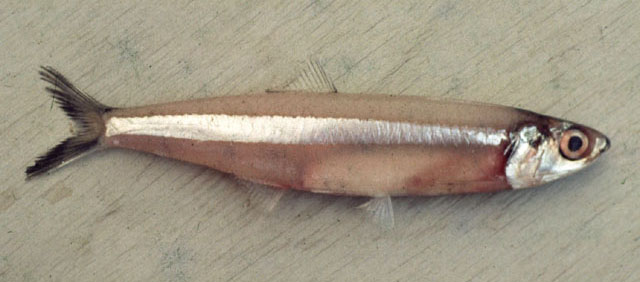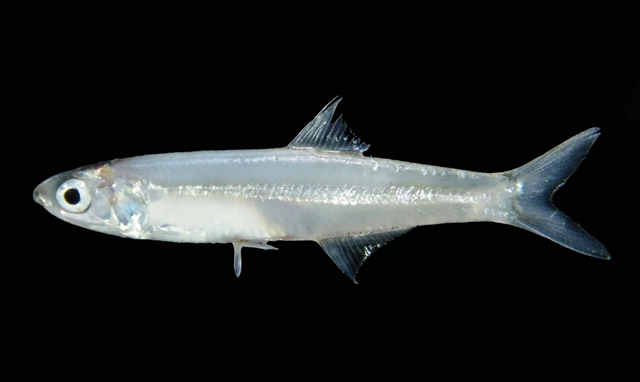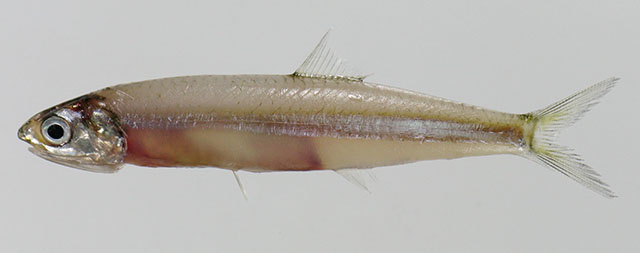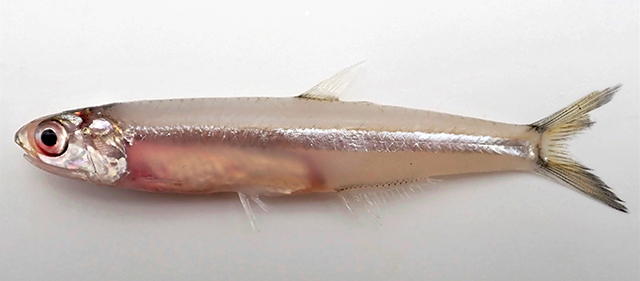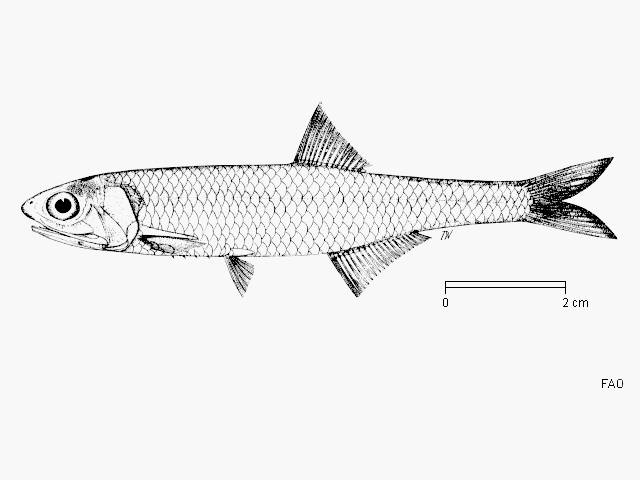Stolephorus
indicus
(van Hasselt,
1823)
Indian anchovy
View all media / Upload your photos and videos
Expand all
Classification / Names
Teleostei (teleosts) > Clupeiformes (Herrings) >
Engraulidae (Anchovies)
> Engraulinae
Etymology: Stolephorus: Greek, stole, -es = garment + Greek, pherein = to carry (Ref. 45335).
More on author:
van Hasselt.
Environment / milieu / depth range / climate zone / distribution range
Distribution
Indian Ocean: from the Red Sea to Ranong and Phuket, Thailand.
Maps

Stolephorus indicus / Native range
AquaMaps Data sources:
GBIF
OBIS
This map was computer-generated and has not yet been reviewed.

Stolephorus indicus / Suitable habitat
AquaMaps Data sources:
GBIF
OBIS
This map was computer-generated and has not yet been reviewed.

Stolephorus indicus / Point map
AquaMaps Data sources:
GBIF
OBIS
This map was computer-generated and has not yet been reviewed.

Stolephorus indicus / Year 2050
AquaMaps Data sources:
GBIF
OBIS
This map was computer-generated and has not yet been reviewed.
Length at first maturity / Size / Weight / Age
Short description
Dorsal spines (total): 0; Dorsal soft rays (total): 15 - 17; Anal spines: 0; Anal soft rays: 19 - 21. Diagnosis: Body slender, elongate, rather round in cross-section, belly rounded, with 2-6 small needle-like pre-pelvic scutes; maxilla tip pointed, reaching to or only just beyond front border of pre-operculum; hind border of pre-operculum convex, rounded; lower gillrakers 20-28; isthmus muscle tapering evenly forward to hind border of branchial membrane; pelvic fin tips not reaching to below dorsal fin origin; anal fin short, with usually 3 unbranched and 16-18 branched finrays, its origin below centre of dorsal fin base; body light transparent fleshy brown, with a silver stripe down flank; no dark pigment lines on back between head and dorsal fin (Ref. 189). Other species with such a short maxilla are Stolephorus advenus, with 7 pre-pelvic scutes, and S. pacificus, with 35-38 gillrakers; maxilla to or almost to hind border of pre-operculum in other Stolephorus species (Ref. 189). Description: Body slender, elongate, rather round in cross-section, belly rounded (Ref. 189). Tip of upper jaw bluntly pointed; maxilla short, not reaching to gill opening, only to front margin of preopercle (Ref. 2871, 5430, 30573). Isthmus continuous, no silvery plate (Ref. 2871). Lower gill rakers 20-28 (Ref. 189, 5430). Pelvic-fin tip not reaching to dorsal-fin origin; anal-fin origin below dorsal-fin base; Dorsal fin with 3 unbranched and 12-14 branched rays; anal fin with 3 unbranched and 16-18 branched rays; pectoral fin with 1 unbranched and 12-15 branched rays; pelvic fin with 1 unbranched and 6 branched rays (Ref. 5430, 30573). Scales: 38-42 lateral line scales (Ref. 5430). With 2-6 small needle-like pre-pelvic scutes, no post-pelvic scutes (Ref. 189, 5430, 30573). Colouration: Body light transparent fleshy brown, with a silver stripe down flank; no dark pigment lines on back between head and dorsal fin (Ref. 189).
Biology
A schooling species occurring in coastal waters and which appears to enter at least the estuarine parts of rivers and to tolerate brackish water. Coastal pelagic (Ref. 68964). Feeds most likely on zooplankton, but more data needed. Used as bait in the tuna fishery in the South Pacific, although said to be fragile. Also Ref. 58652
Life cycle and mating behavior
In Manila Bay, migrates out into deeper and more saline water to breed (at about 9 cm SL and above), returning immediately thereafter.
Main reference
Hata, H., S. Lavoué and H. Motomura 2021 Taxonomic status of nominal species of the anchovy genus Stolephorus previously regarded as synonyms of Stolephorus commersonnii Lacepède 1803 and Stolephorus indicus (van Hasselt 1823), and descriptions of three new species (Clupeiformes: Engraulidae). Ichthyol. Res. 68(3):327-372. (Ref. 123745)
IUCN Red List Status (Ref. 125652)
Least Concern (LC); date assessed: March 02 2017
CITES (Ref. 131153)
Not Evaluated
CMS (Ref. 116361)
Not Evaluated
Threat to humans
Harmless
More information
- Countries
- FAO areas
- Ecosystems
- Occurrences
- Introductions
- Stocks
- Ecology
- Diet
- Food items
- Food consumption
- Ration
- Common names
- Synonyms
- Metabolism
- Predators
- Ecotoxicology
- Reproduction
- Maturity
- Spawning
- Spawning aggregation
- Fecundity
- Eggs
- Egg development
- Age/Size
- Growth
- Length-weight
- Length-length
- Length-frequencies
- Morphometrics
- Morphology
- Larvae
- Larval dynamics
- Recruitment
- Abundance
- References
- Aquaculture
- Aquaculture profile
- Strains
- Genetics
- Allele frequencies
- Heritability
- Diseases
- Processing
- Mass conversion
- Vision
- Pictures
- Stamps, Coins Misc.
- Sounds
- Ciguatera
- Speed
- Swim. type
- Gill area
- Otoliths
- Brains
Estimates based on models
Preferred temperature (Ref. 123201): 24.2 - 28.7, mean 27.9 °C (based on 362 cells).
Phylogenetic diversity index (Ref. 82804): PD50 = 0.5 [Uniqueness, from 0.5 = low to 2.0 = high].
Bayesian length-weight: a=0.00468 (0.00352 - 0.00621), b=3.14 (3.10 - 3.18), in cm total length, based on LWR estimates for this species (Ref. 93245).
Trophic level (Ref. 69278): 3.6 ±0.0 se; Based on diet studies.
Resilience (Ref. 120179): High, minimum population doubling time less than 15 months (K=0.71-1.42).
Fishing vulnerability (Ref. 59153): Low vulnerability (13 of 100).
Price category (Ref. 80766): Low; Questionable: based on ex-vessel price for species in this genus.
Nutrients (Ref. 124155): Calcium = 388 [142, 1,010] mg/100g; Iron = 2.22 [1.20, 3.83] mg/100g; Protein = 18.9 [17.1, 20.8] %; Omega3 = 0.28 [0.12, 0.64] g/100g; Selenium = 59.4 [25.1, 135.9] μg/100g; VitaminA = 25.6 [6.0, 101.2] μg/100g; Zinc = 2.38 [1.55, 3.73] mg/100g (wet weight); based on nutrient studies.

